Ablation Behavior of the SiC-Coated Three-Dimensional Highly Thermal Conductive Mesophase-Pitch-Based Carbon-Fiber-Reinforced Carbon Matrix Composite under Plasma Flame
Abstract
:1. Introduction
2. Experimental Procedures
2.1. Material Preparation
2.2. Ablation and Oxidation Tests
2.3. Material Characterization
3. Results and Discussion
3.1. Microstructure of the Composites
3.2. Ablation Behavior of CMP/C Composite
3.3. Ablation Behavior of SiC-Coated CMP/C Composite
4. Conclusions
Author Contributions
Funding
Conflicts of Interest
Abbreviations
| C/C composite | The carbon-fiber-reinforced carbon matrix (C/C) composite |
| CF | carbon fiber |
| PAN | polyacrylonitrile |
| CFPAN | PAN-based carbon fiber |
| CFMP | mesophase pitch-based carbon fiber |
| CMP/C composite | C/C composite prepared using the CFMP in the X (Y) direction and the CFPAN in the Z direction in this study |
| CPAN/C composite | C/C composite prepared using the CFPAN in all directions |
| CVI | chemical vapor infiltration |
| PIP | polymer infiltration and pyrolysis |
| CVR | chemical vapor reaction |
References
- Sheehan, J.E.; Buesking, K.W.; Sullivan, B.J. Carbon-Carbon Composites. Annu. Rev. Mater. Sci. 1994, 24, 19–44. [Google Scholar] [CrossRef]
- Fitzer, E. The future of carbon-carbon composites. Carbon 1987, 25, 163–190. [Google Scholar] [CrossRef]
- Zhang, X.; Li, X.; Yuan, G.; Dong, Z.; Ma, G.; Rand, B. Large diameter pitch-based graphite fiber reinforced unidirectional carbon/carbon composites with high thermal conductivity densified by chemical vapor infiltration. Carbon 2017, 114, 59–69. [Google Scholar] [CrossRef]
- Manocha, L.M.; Warrier, A.; Manocha, S.; Sathiyamoorthy, D.; Banerjee, S. Thermophysical properties of densified pitch based carbon/carbon materials—I. Unidirectional composites. Carbon 2006, 44, 480–487. [Google Scholar] [CrossRef]
- Li, T.; Xu, Z.; Hu, Z.; Yang, X. Application of a high thermal conductive C/C composite in a heat-redistribution thermal protection system. Carbon 2010, 48, 924–925. [Google Scholar] [CrossRef]
- Lachaud, J.; Aspa, Y.; Vignoles, G.L. Analytical modeling of the steady state ablation of a 3D C/C composite. Int. J. Heat Mass Transf. 2008, 51, 2614–2627. [Google Scholar] [CrossRef] [Green Version]
- Lee, K.J.; Chen, Z.Y. Microstructure study of PAN–pitch-based carbon–carbon composite. Mater. Chem. Phys. 2003, 82, 428–434. [Google Scholar] [CrossRef]
- Baxter, R.I.; Rawlings, R.D.; Iwashita, N.; Sawada, Y. Effect of chemical vapor infiltration on erosion and thermal properties of porous carbon/carbon composite thermal insulation. Carbon 1999, 38, 441–449. [Google Scholar] [CrossRef]
- Kumar, S.; Kushwaha, J.; Mondal, S.; Kumar, A.; Jain, R.K.; Devi, R.G. Fabrication and ablation testing of 4D C/C composite at 10MW/m2 heat flux under a plasma arc heater. Mater. Sci. Eng. A 2013, 566, 102–111. [Google Scholar] [CrossRef]
- Levet, C.; Helber, B.; Couzi, J.; Mathiaud, J.; Gouriet, J.B.; Chazot, O.; Vignoles, G.L. Microstructure and gas-surface interaction studies of a 3D carbon/carbon composite in atmospheric entry plasma. Carbon 2017, 114, 84–97. [Google Scholar] [CrossRef]
- Newcomb, B.A. Processing, structure, and properties of carbon fibers. Compos. Part A Appl. Sci. Manuf. 2016, 91, 262–282. [Google Scholar] [CrossRef]
- Emmerich, F.G. Young’s modulus, thermal conductivity, electrical resistivity and coefficient of thermal expansion of mesophase pitch-based carbon fibers. Carbon 2014, 79, 274–293. [Google Scholar] [CrossRef]
- Mochida, I.; Yoon, S.H.; Takano, N.; Fortin, F.; Korai, Y.; Yokogawa, K. Microstructure of mesophase pitch-based carbon fiber and its control. Carbon 1996, 34, 941–956. [Google Scholar] [CrossRef]
- Wu, S.; Liu, Y.; Ge, Y.; Ran, L.; Peng, K.; Yi, M. Surface structures of PAN-based carbon fibers and their influences on the interface formation and mechanical properties of carbon-carbon composites. Compos. Part A Appl. Sci. Manuf. 2016, 90, 480–488. [Google Scholar] [CrossRef]
- Paiva, M.C.; Bernardo, C.A.; Nardin, M. Mechanical, surface and interfacial characterisation of pitch and PAN-based carbon fibers. Carbon 2000, 38, 1323–1337. [Google Scholar] [CrossRef]
- Qin, X.; Lu, Y.; Xiao, H.; Wen, Y.; Yu, T. A comparison of the effect of graphitization on microstructures and properties of polyacrylonitrile and mesophase pitch-based carbon fibers. Carbon 2012, 50, 4459–4469. [Google Scholar] [CrossRef]
- Yuan, G.; Li, X.; Dong, Z.; Xiong, X.; Rand, B.; Cui, Z.; Cong, Y.; Zhang, J.; Li, Y.; Zhang, Z.; et al. Pitch-based ribbon-shaped carbon-fiber-reinforced one-dimensional carbon/carbon composites with ultrahigh thermal conductivity. Carbon 2014, 68, 413–425. [Google Scholar] [CrossRef] [Green Version]
- Adams, P.M.; Katzman, H.A.; Rellick, G.S.; Stupian, G.W. Characterization of high thermal conductivity carbon fibers and a self-reinforced graphite panel. Carbon 1988, 36, 233–245. [Google Scholar] [CrossRef]
- Luo, R.; Liu, T.; Li, J.; Zhang, H.; Chen, Z.; Tian, G. Thermophysical properties of carbon/carbon composites and physical mechanism of thermal expansion and thermal conductivity. Carbon 2004, 42, 2887–2895. [Google Scholar] [CrossRef]
- Baxter, R.I.; Iwashita, N.; Sawada, Y. Effect of halogen purification and heat treatment on thermal conductivity of high porosity carbon/carbon composite thermal insulation. J. Mater. Sci. 2000, 35, 2749–2756. [Google Scholar] [CrossRef]
- Klett, J.W.; Ervin, V.J.; Edie, D.D. Finite-element modeling of heat transfer in carbon/carbon composites. Compos. Sci. Technol. 1999, 59, 593–607. [Google Scholar] [CrossRef]
- Ai, S.G.; He, R.J.; Pei, Y. M A numerical study on the thermal conductivity of 3d woven c/c composites at high temperature. Appl. Compos. Mater. 2015, 22, 823–835. [Google Scholar]
- Li, K.; Shen, X.; Li, H.; Zhang, S.; Feng, T.; Zhang, L. Ablation of the carbon/carbon composite nozzle-throats in a small solid rocket motor. Carbon 2011, 49, 1208–1215. [Google Scholar] [CrossRef]
- Li, H.; Yao, X.; Zhang, Y.; Li, K.; Guo, L.; Liu, L. Effect of heat flux on ablation behaviour and mechanism of C/C-ZrB2-SiC composite under oxyacetylene torch flame. Corros. Sci. 2013, 74, 265–270. [Google Scholar] [CrossRef]
- Yoon, S.; Korai, Y.; Mochida, I. Crack formation in mesophase pitch-based carbon fibres: Part II Detailed structure of pitch-based carbon fibres with some types of open cracks. J. Mater. Sci. 1997, 32, 2759–2769. [Google Scholar] [CrossRef]
- Li, C.Y.; Li, K.Z.; Li, H.J.; Ouyang, H.B.; Zhang, Y.L.; Guo, L.J. Ablation resistance and thermal conductivity of carbon/carbon composites containing hafnium carbide. Corros. Sci. 2013, 75, 169–175. [Google Scholar] [CrossRef]

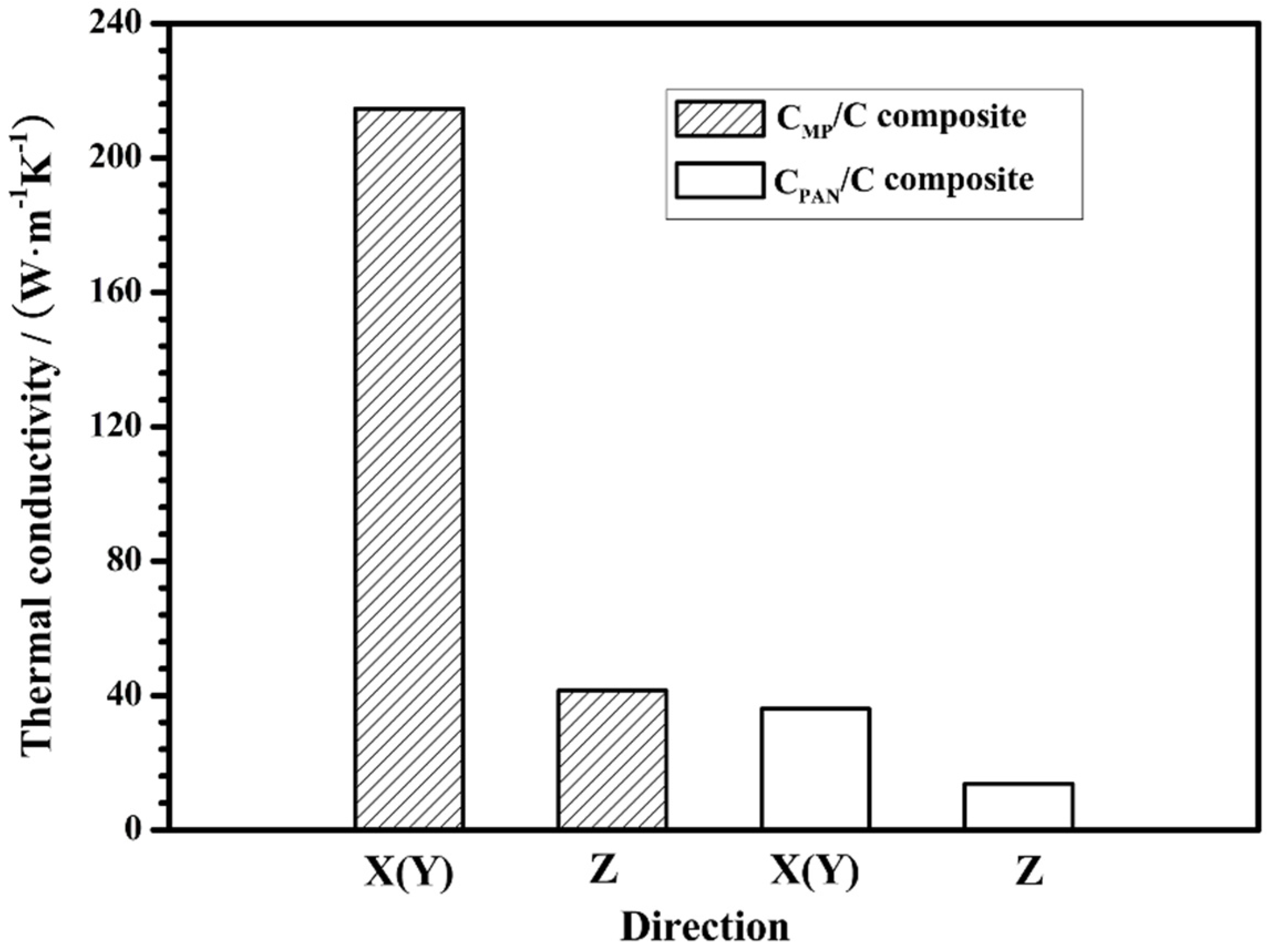
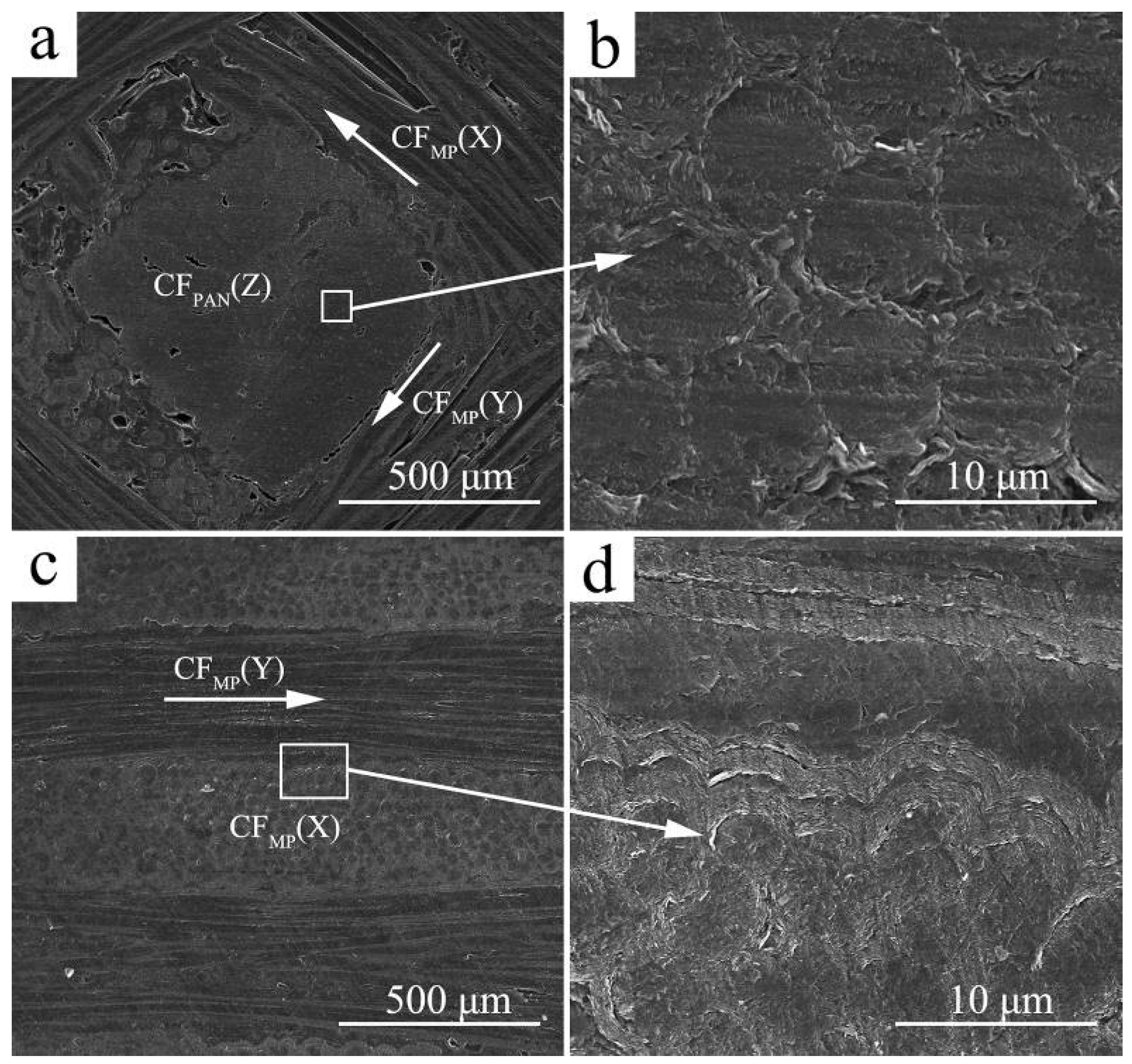

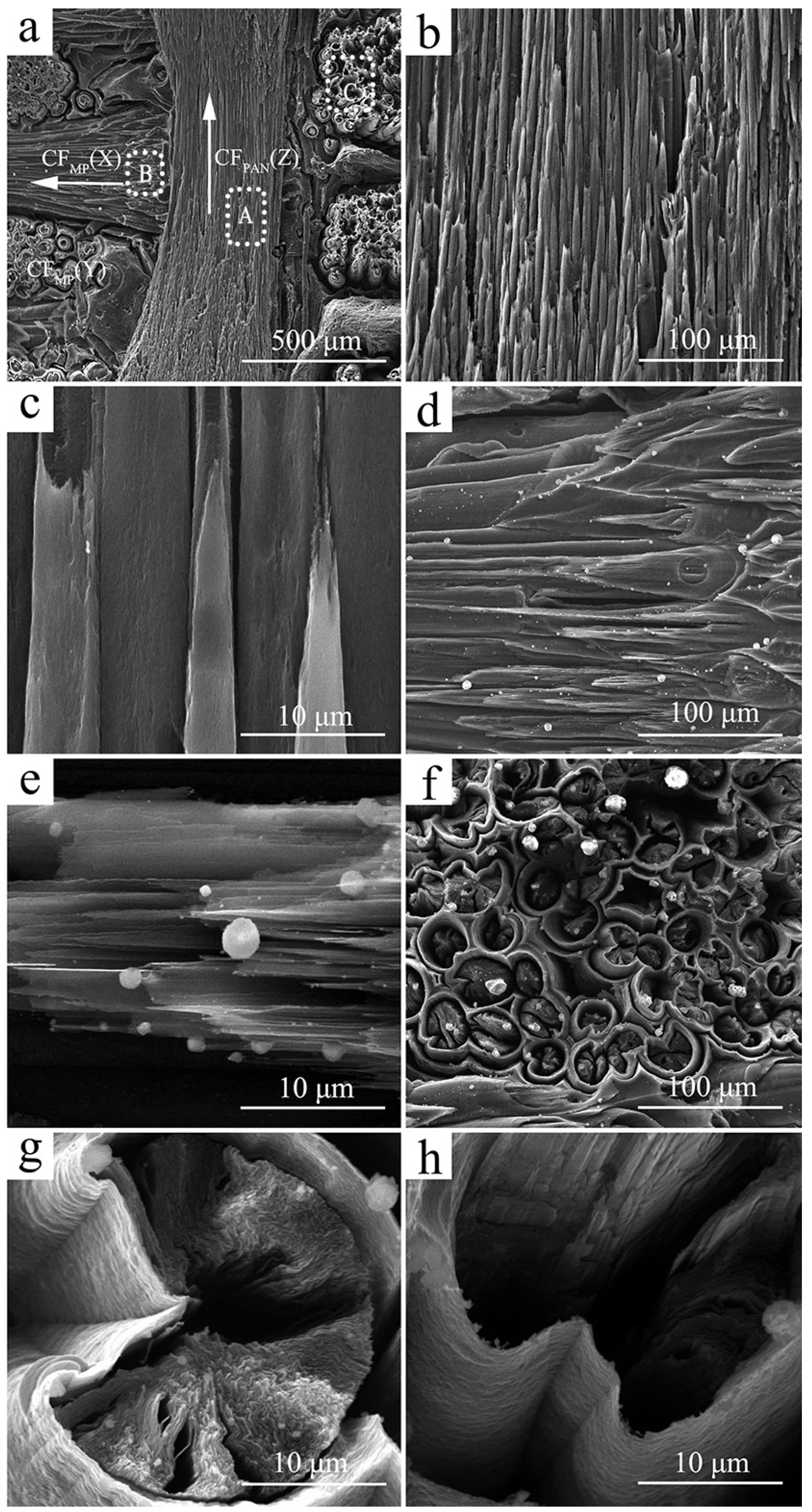

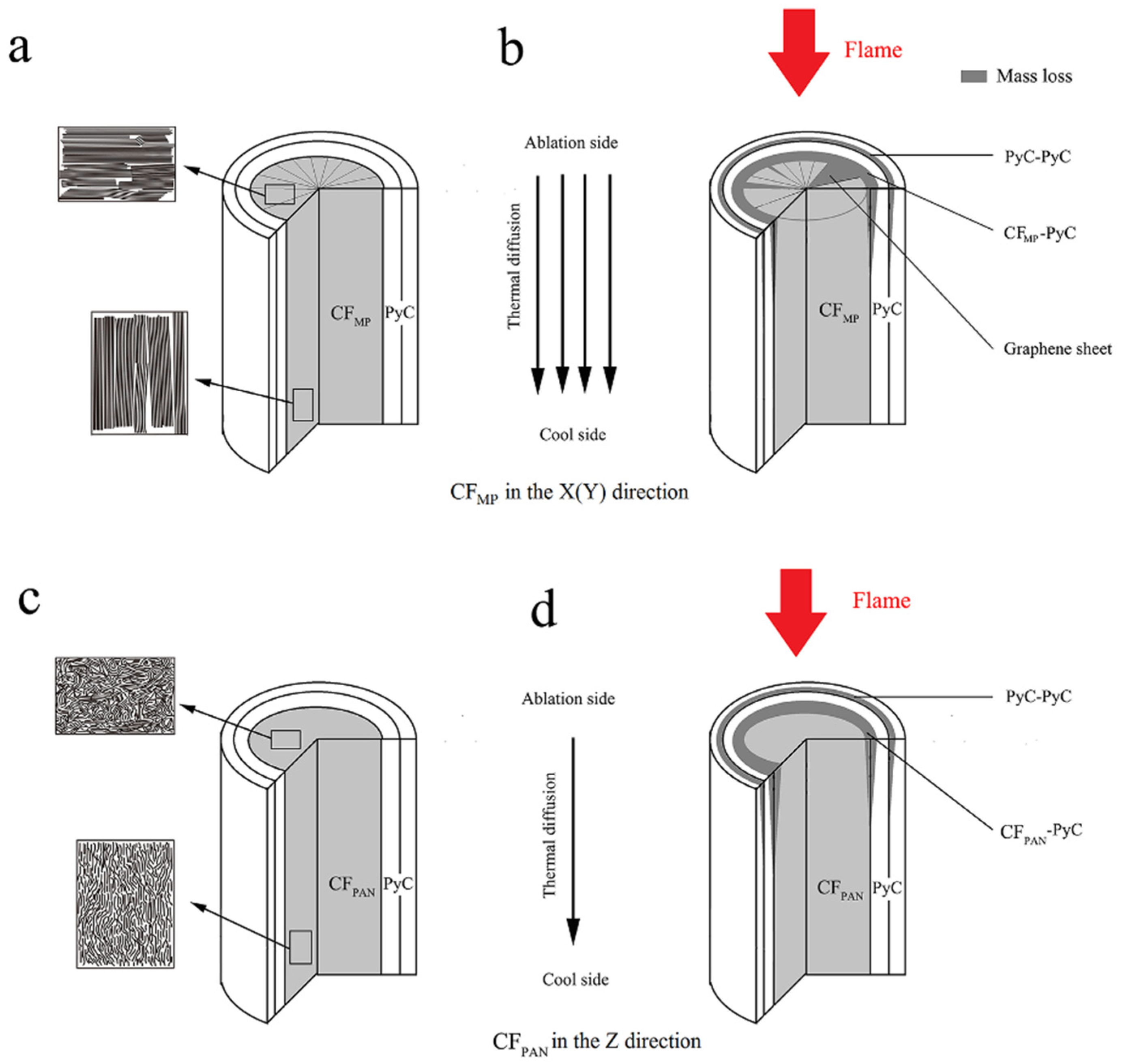

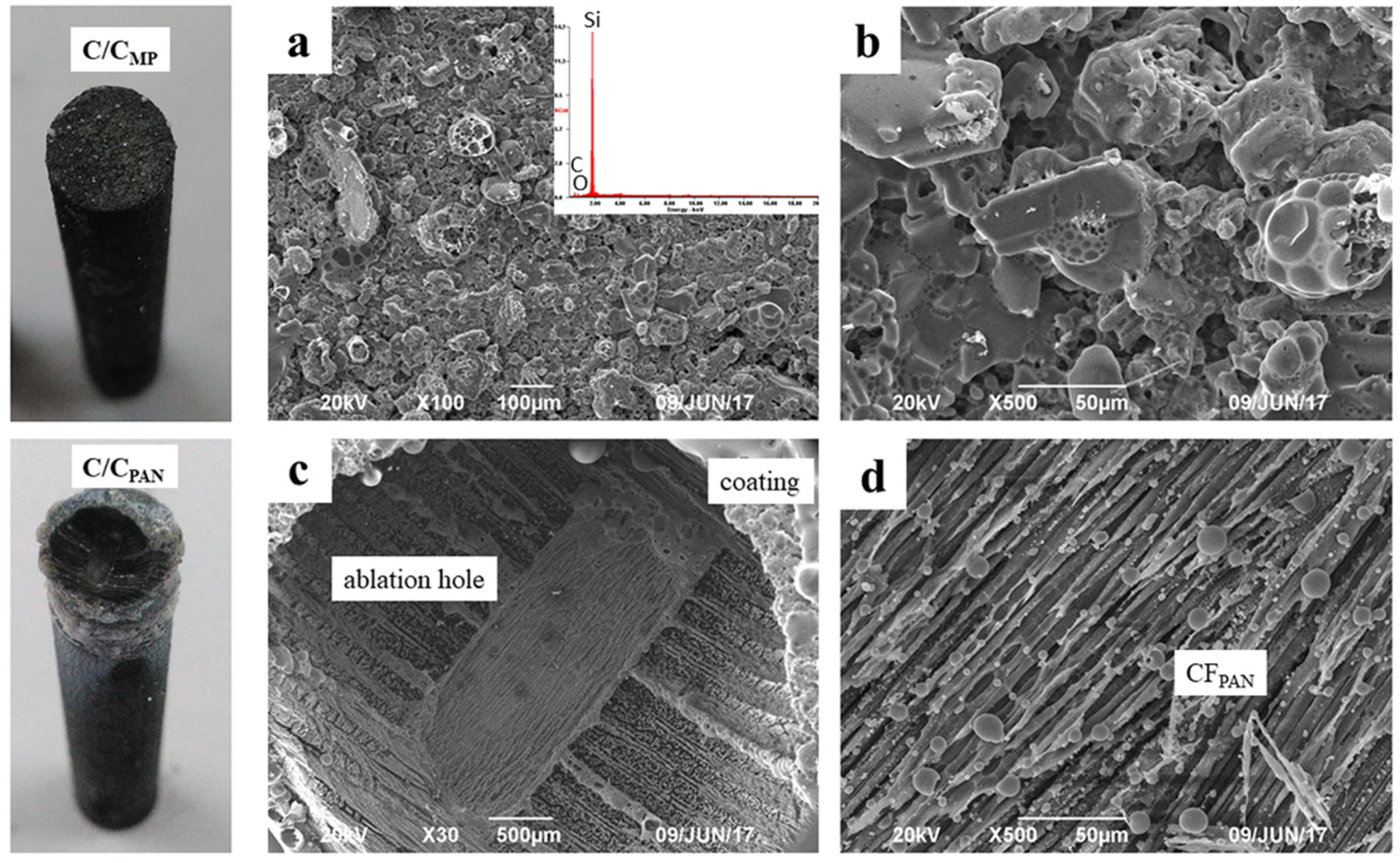
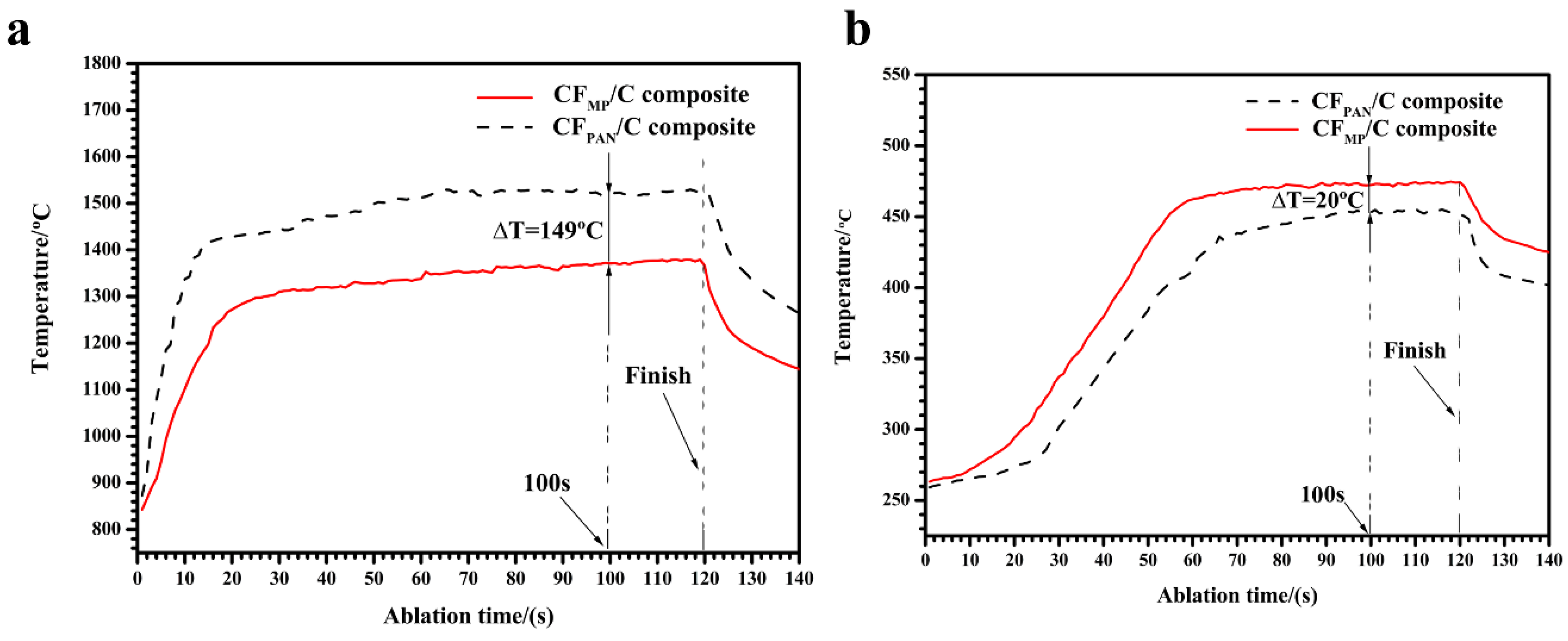
| Thermal Conductivity (W·m−1·K−1) | Volume Fraction (%) | Direction | |
|---|---|---|---|
| CFMP | ≥700 | 36 | X, Y |
| CFPAN | ~10 | 8–10 | Z |
| Sample | Linear Ablation Rate (μm·s−1) | Mass Ablation Rate (mg·cm−2·s−1) |
|---|---|---|
| SiC-coated CMP/C | 0.52 | 0.19 |
| SiC-coated CPAN/C | 13.57 | 1.44 |
| CMP/C | 28.21 | 12.24 |
| CPAN/C | 26.45 | 11.31 |
© 2019 by the authors. Licensee MDPI, Basel, Switzerland. This article is an open access article distributed under the terms and conditions of the Creative Commons Attribution (CC BY) license (http://creativecommons.org/licenses/by/4.0/).
Share and Cite
Ye, C.; Huang, D.; Li, B.; Yang, P.; Liu, J.; Wu, H.; Yang, J.; Li, X. Ablation Behavior of the SiC-Coated Three-Dimensional Highly Thermal Conductive Mesophase-Pitch-Based Carbon-Fiber-Reinforced Carbon Matrix Composite under Plasma Flame. Materials 2019, 12, 2723. https://doi.org/10.3390/ma12172723
Ye C, Huang D, Li B, Yang P, Liu J, Wu H, Yang J, Li X. Ablation Behavior of the SiC-Coated Three-Dimensional Highly Thermal Conductive Mesophase-Pitch-Based Carbon-Fiber-Reinforced Carbon Matrix Composite under Plasma Flame. Materials. 2019; 12(17):2723. https://doi.org/10.3390/ma12172723
Chicago/Turabian StyleYe, Chong, Dong Huang, Baoliu Li, Pingjun Yang, Jinshui Liu, Huang Wu, Jianxiao Yang, and Xuanke Li. 2019. "Ablation Behavior of the SiC-Coated Three-Dimensional Highly Thermal Conductive Mesophase-Pitch-Based Carbon-Fiber-Reinforced Carbon Matrix Composite under Plasma Flame" Materials 12, no. 17: 2723. https://doi.org/10.3390/ma12172723






